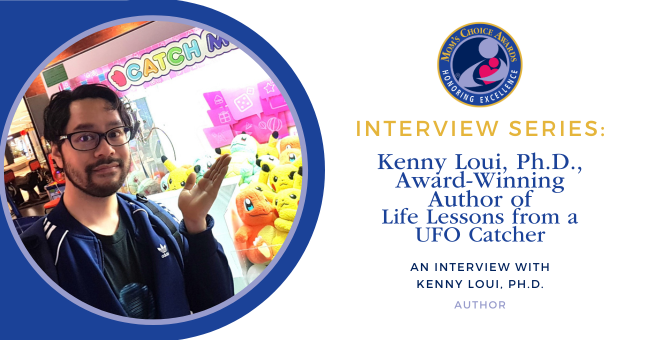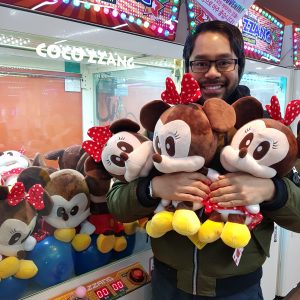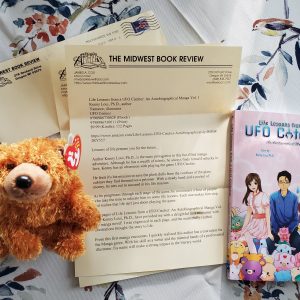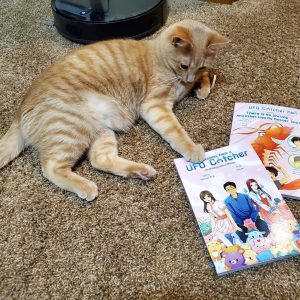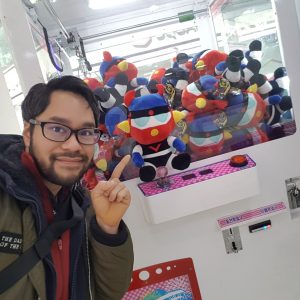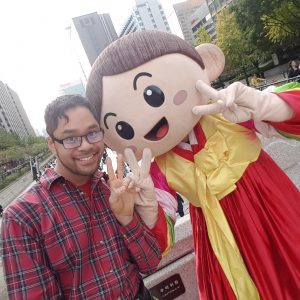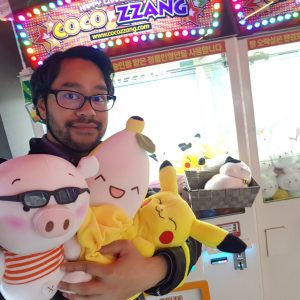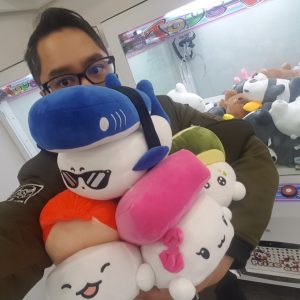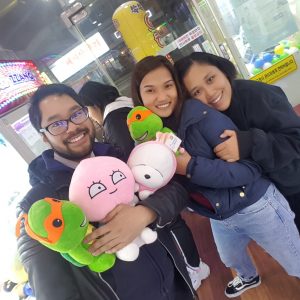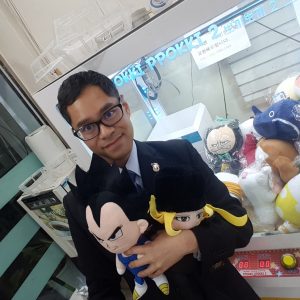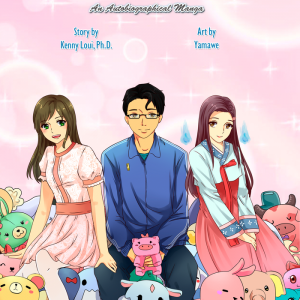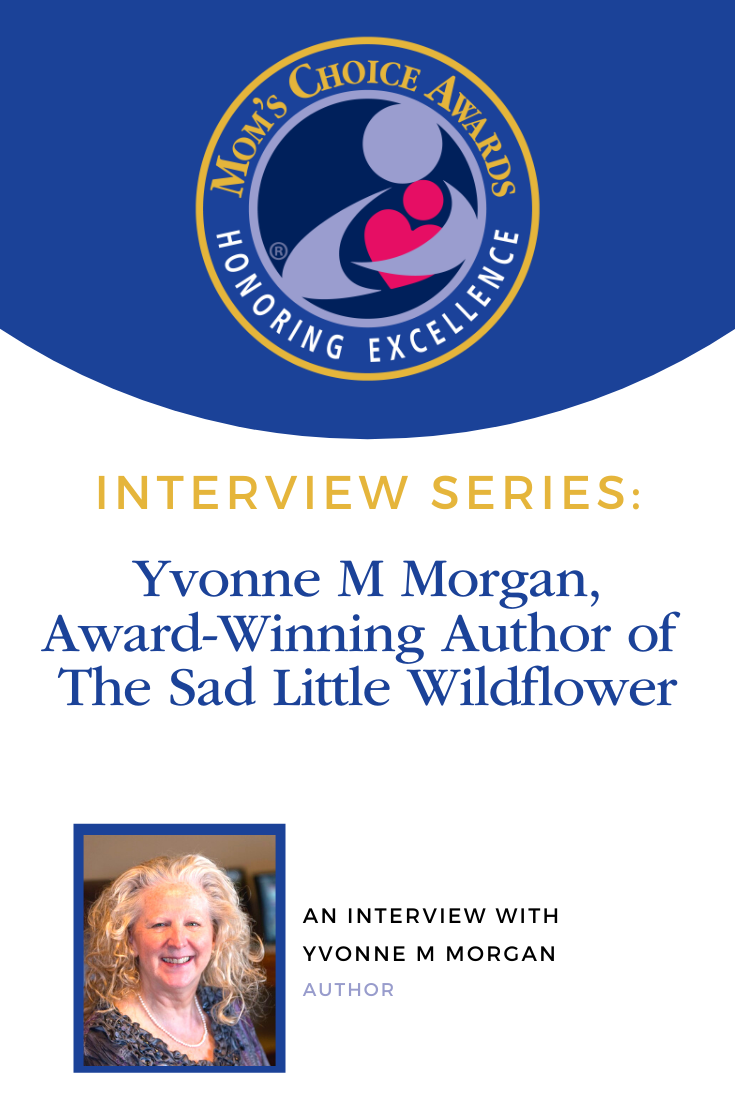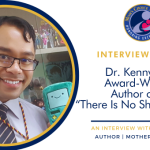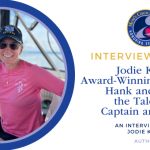Mom’s Choice Awards is excited to announce another post in our interview series where we chat with the inventors, designers, publishers, and others behind some of our favorite family-friendly products.
Hello, Mom’s Choice readers Hello, Mom’s Choice readers! We were delighted to get the opportunity to speak with Kenny Loui, Ph.D.—the author of the extraordinary graphic novel, Life Lessons from a UFO Catcher: An Autobiographical Manga. This debut graphic novel has won numerous accolades and awards. In it, he serves up pop culture from various countries and puts it together in a captivating, fresh new way—along with valuable life lessons for teen and young adult readers, and plenty of enjoyable features for an older audience, as well. The book also talks about the importance of juggling two critical pluses: thinking outside the box and staying the course!
MCA: Hi Kenny, thank you so much for joining us! Life Lessons from a UFO Catcher is a fascinating mix of so many interesting elements. Congratulations on this—dare I say—very novel effort! But first, can we start the interview by your telling us a bit about yourself?
I was born and raised in San Francisco, California, and lived there for most of my life until I caught the study-abroad bug in college. After spending a year in Japan and returning home to finish up my first round of grad school, I received a Fulbright Scholarship to South Korea. That one year in Korea eventually turned into two, and two years soon turned into three. Before I knew it, I found myself bouncing back and forth across the Pacific Ocean, between my home and my new one for just over a decade of my life.
During my back-and-forth between the United States and South Korea, I worked as a professor of police administration and international legal studies, while simultaneously attending graduate school and working on my Ph.D. in criminal justice, which I completed in 2017. In August 2020, I made the big move back Stateside, accepting a job offer at Loras College in Dubuque, Iowa, where I currently work as a professor of criminal justice, teaching classes in criminology, juvenile justice and criminal investigations, among others.
Based on the visuals in my PowerPoint presentations and the many pop cultural references that I make during class lectures, my students know right from day one that I am a comic book geek and Japanese anime and manga otaku. In fact, one of my favorite classes is one I had the opportunity to develop and teach during my second year at Loras—Law, Crime and Pop Culture Diplomacy—a course that combines my love of comparative criminology and East Asian pop culture and offers students the opportunity to learn about these topics through creative and interactive activities, such as creating their own comics and webtoons.
MCA: You obviously had—and still have—many different interests. So let me ask, what was your path to becoming a writer like? What inspired you?
For as long as a can remember, I’ve been deemed a “good writer” by my teachers and professors. I think all the writing awards I’ve earned over the years—ranging from departmental and university-wide awards to national awards that are listed on my resume/CV—more or less support that. However, all those awards have very much been for my academic writing ability. It’s been a secret for a while, but a secret that’s now out of the bag with the recent release of Life Lessons from a UFO Catcher, my debut graphic novel: In addition to academic writing, I also have an interest in creative writing.
As alluded to earlier, I’m an avid reader of American comics and Japanese manga. Although I consider myself a better writer than an artist, I used to do both in my younger days—writing, doodling, and creating my own indie comics in elementary and middle school. However, my audience and fanbase were pretty small, limited to friends, family and classmates.
In fact, during a “career day” activity in fifth grade, in which students had to dress up as and give a presentation on what they wanted to be when they grew up, I had the opportunity to let my creativity shine. I came to school that day dressed as a comic book writer/artist—basically, a Batman T-shirt with Superman suspenders and an X-Men cap—and debuted a few of my creations during my presentation, including a hand-drawn comic book and some trading cards.
I obviously pursued a very different career path, but I’m glad that I’ve been able to tap into my childhood love of creative writing in recent years and partner up with my friend and amazing artist, Yamawe, to create Life Lessons from a UFO Catcher.
MCA: And what a fascinating journey it’s obviously been! Tell us, what was your inspiration for writing Life Lessons from a UFO Catcher: An Autobiographical Manga?
There were several inspirations. First was my desire to tap into my childhood dream of being a comic book creator. Although I dabbled in creative writing and illustrations in my younger days, as I got older and life got busier, writing and illustrating stories took a backseat to everything else that was going on in my life. Nonetheless, whenever I had spare time, I’d write and doodle in a journal or even on random napkins at restaurants and cafés that I frequented—writing about my day, random thoughts, or whatever was on my mind. While writing my doctoral dissertation, I’d sometimes revisit those old journal entries and random notes—and started putting the fragments together like pieces of a puzzle. Those “puzzle pieces,” a lot of them about important lessons I learned in life, soon became the basis for Life Lessons from a UFO Catcher.
My second inspiration came very much from my experience living in Japan and South Korea. This is obvious, given that the setting of the story is an arcade in Korea and the protagonist plays crane games—referred to as “UFO catchers” in Japan—for most of the story. The idea for having an arcade and “UFO catching” be central to the narrative stemmed from my favorite pastime while living in Japan and Korea. After work and on the weekends, I’d often visit the local arcade to play retro video games and crane games. I actually got pretty good at crane games, figuring out strategies to “liberate” the plush dolls, toys, and random thingamabobs that I’d find “trapped” in those claw machines. Soon my newfound hobby became an obsession and life mission of sorts: To rescue all the plushies!
The third inspiration for writing this book is my experience as a teacher and mentor for diverse populations—from elementary school students to university students, Civil Air Patrol cadets, aspiring law enforcement officers, and list goes on—in a variety of educational settings around the globe. Whatever group of students I am teaching and wherever I am teaching them, more times than not I will go beyond the textbook and draw upon my own life experiences as they relate to the topics we discuss, while engaging my students to examine and reflect upon their related experiences. In that respect, we are all teachers and students to each other. And that’s very much my goal with Life Lessons from a UFO Catcher—to share with readers some of the important lessons I learned in life, while encouraging them to reflect on the lessons learned from their own life experiences.
MCA: Can you share with our readers what some of the key lessons are that can be found in your book?
This graphic novel contains 13 short “episodes,” each one featuring a life lesson narrated by the protagonist through an internal monologue with the episode’s events depicting the lesson taught. In brief, there are 13 life lessons in this book. Well, technically, 14 if you count the epilogue. The protagonist of the story is essentially me in my younger days, when I was brash, impulsive, and a bit temperamental. Thus, some of the key lessons found in the book focus on being patient and controlling your anger. To quote a Chinese proverb my grandfather often told me, which is at the heart of the final episode of the book: “忍得一时之氣,免得百日之忧,” or in English, “If you are patient in one moment of anger, you will escape one-hundred days of sorrow.” My hot head got me into a lot of trouble and regrettable situations in my younger days. The climax of Life Lessons from a UFO Catcher is a perfect example of that.
MCA: If you could ensure readers of your book walk away with one main lesson, what would it be?
One main lesson? Truth be told, it’s hard to pick just one. As a matter of fact, it was hard for me to select the 13 lessons that were included in this book. My original notes and outline of the series contain a little over 100 lessons. The 13 found in this book were merely the ones I wanted to start off Volume 1 with. Yes, there are more Life Lessons from a UFO Catcher to come in the near future!
Anyway, the key point is: There’s more than one way to get what you want, and more than one route to get to your intended destination. If one way doesn’t work, try something else … and you may have to get a little creative or think outside of the box sometimes. Related to that lesson is the importance of being patient and staying the course, which is a lesson also featured in the book!
But back to your question: If I could pick just one lesson for readers to walk away with, it would be the one in Episode 3, “I Love It When a Plan Comes Together,” which features the protagonist’s first plushie “rescue.” The lesson of that relatively brief episode is to always have a backup plan or two. That was a lesson I learned very early in life, as things I did—or sought to do—didn’t always go as planned. But instead of giving up, I tried another method or took another path or get where I wanted to go.
To visualize and represent that lesson in the context of Kenny’s UFO-catching exploits, I had the protagonist do the logical, intuitive thing that most crane game players will do at first glance: Use the claw to grab the object of their desire and hope that the claw’s grip is strong enough to hold onto that object—be it a plush doll, boxed action figure, or whatever they’re trying to get—until the claw positions itself by the hole and drops the object into it, resulting in the player’s victory. Those who have played crane games before know that’s usually not going to be the case, at least on the first try. In brief, the claw is either too weak to pick up the object or will loosen its grip on the object before the claw reaches the drop zone. That is what Kenny experiences in this particular episode, so instead of using the claw to grab the plushie, he tries out an alternative approach. Does his Plan B lead to victory? You’ll have to read the story to find out!
MCA: Clearly, a lot of people are doing just that—reading your book. What kind of responses have you received from them?
I’ve been surprised and delighted by the positive responses I’ve received from my debut graphic novel, from both editorial reviews and reader reviews, including those from Kirkus Reviews, Indies Today, San Francisco Book Review, and Midwest Book Review. I was particularly surprised by the mostly positive review from Kirkus Reviews, which has a reputation among the literary community for being a bit “harsh.” To quote an excerpt from the review: “This entertaining, pleasantly mellow story … brims with exuberance and features an animated cast. … Readers will surely welcome more of Kenny’s antics in future volumes.”
MCA: It seems that the artwork has won accolades, as well.
Yes, it has. In fact, hearing the positive comments about the artwork reiterated to me that I picked the right artist to visualize my words and bring “ani-me” and the story’s other quirky characters to life. To quote Kirkus Reviews again: “Yamawe’s dynamic, manga-inspired illustrations perfectly suit Loui’s tone.” Theresa Kadair of San Francisco Book Review goes into a more detailed discussion on Yamawe’s art and how it enhances the story:
“As a whole, I enjoyed the plot of all the episodes and found them to be cheerful reminders of timeless advice. But, one of the most notable things about this manga was the gorgeous illustrations done by Yamawe. Truly, she outdid herself. With manga, the artwork is such a crucial, make-or-break component of the novel, and I am happy to say she truly made this book unique! Her attention to detail, color, and precision makes this novel come to life. I loved the way she played with pigments to show shadows, light, texture, and emotion on all of the characters and the scenery.”
I am grateful for Yamawe’s contributions to this project. I would not have been able to do this without her and am so blessed that she was interested and willing to work with me on Life Lessons from a UFO Catcher and its spinoff prequel/sequel, There is No Shrimp … And Other Lies My Mother Told Me.
To be honest, I wasn’t expecting anyone to read or purchase the book outside of Yamawe and my immediate family members since we’re independently published and hardly “brand name” manga creators like Naoko Takeuchi, Rumiko Takahashi, and Tatsuya Endo. So needless to say, we were awestruck to see a “#1 New Release” banner on the book’s listing on Amazon when it debuted in June as well becoming the #1 best seller in the Nonfiction Manga category and #5 best seller in the Teen & Young Adult Biography Comics category.
Lastly, I was delighted to see articles about Life Lessons from a UFO Catcher and its Mom’s Choice Award win featured in The Telegraph Herald and Julien’s Journal, two periodicals in Dubuque, Iowa, where I currently reside.
All in all, Yamawe and I are so happy about the generally positive reception Life Lessons from a UFO Catcher has gotten from professional reviewers and readers alike.
MCA: What a gratifying reception for a debut novel! Tell me, what groups might be most interested in your book, and why?
Although the book is intended for young adults, ages 13 and up, I think older adults—in particular, parents and teachers—will enjoy the story as well, especially those of a certain age as I’ve embedded some 1980s and 1990s pop culture into the narrative. Readers who are into anime and manga, arcade gaming, and slice-of-life comedies may also take interest. Like with anything else, the book isn’t going to be everyone’s preferred cup of tea. Nonetheless, I hope potential readers will give it a shot and find something in the book that’s of interest to them—whether it’s the morals and life lessons, quirky characters, cute plushies, slice-of-life stories, the manga-inspired artwork by Yamawe, or even the ‘80s and ‘90s pop cultural references.
Although the book features a relatively simple story that takes place entirely in an arcade and focuses on a guy playing crane games, it contains some valuable life lessons that can be attributed to various circumstances and situations, and that people from all walks of life can appreciate and connect with. Think of it as being akin to Aesop’s Fables, but with a modern-day twist, a quirky cast of characters, and an awesome retro ‘80s soundtrack.
I hope that readers will be able to connect with the life lessons I’ve learned—and I have many more to share in the next volume of Life Lessons from a UFO Catcher—while reflecting on the important lessons in their own lives.
MCA: With so many interests that you have, and all the lessons you’ve mentioned, what’s next for your writing endeavors?
As I mentioned earlier, I have a little over 100 life lessons jotted down in my notes. This book contains only 13 of those lessons. Yamawe and I are already working on “Season 2” of Life Lessons from a UFO Catcher, which introduces some new characters including Kenny’s twin sisters, a love interest for Kenny, and a bear—or is it a cat?—plush doll that spurs some antics and arguments between Kenny and his potential soulmate. I also have outlines and partially completed scripts for three additional “seasons” after that, and have already written the script for the final episode of the series, which may or may not include an appearance by an unidentified flying object. In brief, I have a road map and a planned final destination for this story.
Yamawe and I started working together on this project in January 2019, and the book was published in June 2023, so it took us 4.5 years to get this done. Completion of Volume 2 will probably move a lot quicker than that since I worked on the scripts for the first two volumes back-to-back, much like how filming of Superman: The Movie and Superman II were done simultaneously. Sorry, I had to get that bit of pop culture trivia out of my system. Anyway, taken together, Life Lessons from a UFO Catcher Seasons 1 and 2 can be read and viewed as one complete “saga,” with Season 3—if we do get to a Season 3!—beginning a new chapter in Kenny’s UFO-catching adventures and well as exploring our protagonist’s life beyond the arcade.
Whether the UFO Catcher series ends on a cliffhanger or gets to its intended epic grand finale will depend on a variety of factors, including, but not limited to, Yamawe and my work schedules—we both have full-time jobs and other commitments that keep us quite busy, so this endeavor is very much a side gig/hobby for us—and support from our fans and readers.
In closing, to anyone who has given our debut graphic novel a glance: If you want to see more Life Lessons from a UFO Catcher, please reach out to us via social media, email or even good old-fashioned snail mail and let us know. We appreciate your support, words of encouragement, or even honest reviews of our book on Amazon or Goodreads! Thank you for reading and joining us on our UFO-catching adventures!
MCA: I’m sure your many fans look forward to reading upcoming graphic novels. On behalf of the Mom’s Choice Awards, may I wish you the very best of luck with all future endeavors!
You can learn more about Kenny Loui, Ph.D. and his award-winning book, Life Lessons from a UFO Catcher: An Autobiographical Manga by visiting his MCA Shop pages.

